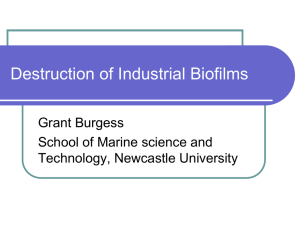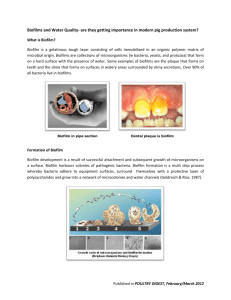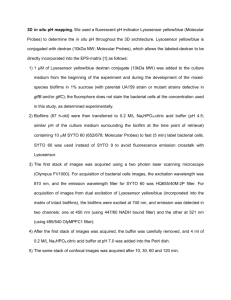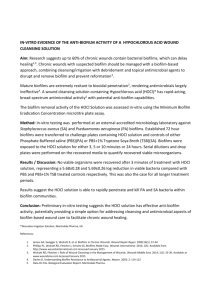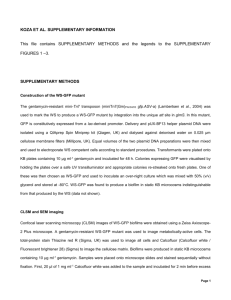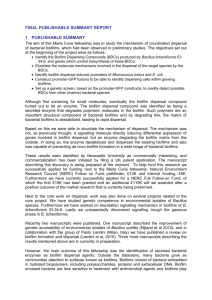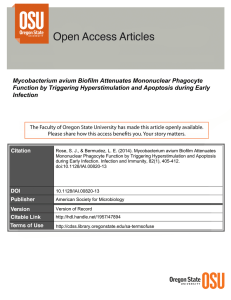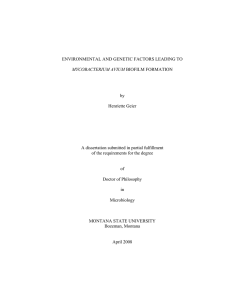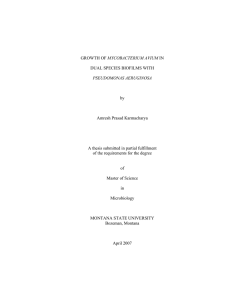Biofilm Formation in Mycobacterium smegmatis
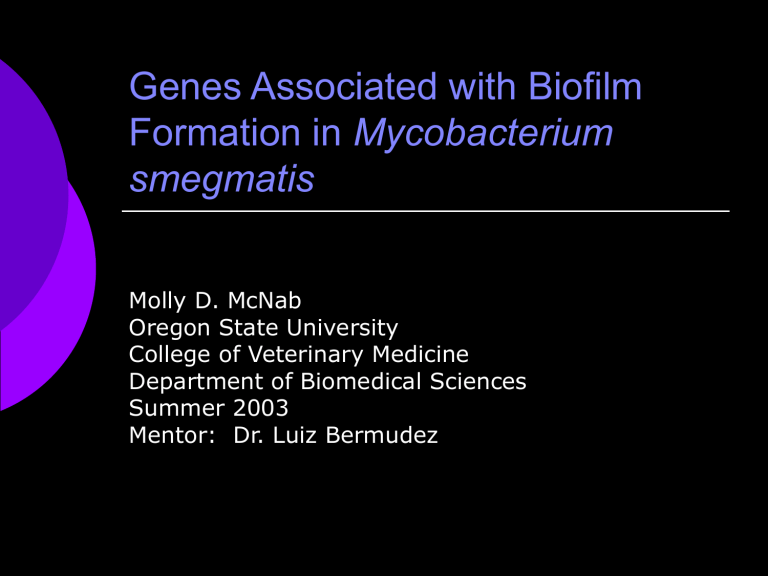
Genes Associated with Biofilm
Formation in Mycobacterium smegmatis
Molly D. McNab
Oregon State University
College of Veterinary Medicine
Department of Biomedical Sciences
Summer 2003
Mentor: Dr. Luiz Bermudez
What is Biofilm?
Biofilms are multicellular aggregates of bacteria and yeast that congregate on surfaces.
Biofilm may form on any surface exposed to biofilm-forming bacteria and some amount of water.
Biofilms are formed to protect the bacteria from host defenses, antibiotics, and from harsh environmental conditions.
Where are Biofilms Found?
Biofilms are found almost everywhere in nature, including rivers, lakes, soil, water pipes, and even inside the human body.
A common type of bacterial biofilm-responsible for plaque.
Bacterial biofilms are often a cause of infections associated with medical implants such as catheters and IV lines and other medical devices.
Why Research Biofilms?
Due to the morphology of biofilms, bacteria capable of forming them are highly resistant to antibiotics, making treatment very difficult.
In the US alone, one million nosocomial
(hospital acquired) infections each year are caused by bacterial biofilms, leading to longer hospitalization, surgery, and even death.
Biofilms and Infections:
Biofilms are responsible for Otitis Media, the most common acute ear infection.
Biofilms play a role in Bacterial Endocarditis
(infection of the inner surface of the heart and its valves).
Biofilms form frequently in patients with Cystic
Fibrosis (a chronic disorder resulting in increased susceptibility to serious lung infections).
Biofilms also play a role in Legionnaire's
disease (an acute respiratory infection resulting from the aspiration of clumps of Legionnella biofilms detached from air and water heating/cooling and distribution systems).
How are Biofilms Formed?
Biofilm formation relies on an exchange of chemical signals between cells in a process known as “quorum sensing.”
Quorum Sensing
Quorum sensing is required for natural biofilm formation.
When enough bacteria (a quorum) are present, diffusible signal molecules produced by the bacteria allow for communication with others in order to coordinate their behavior.
Mycobacteria: An Overview
There are >70 species of mycobacteria, many of which are human pathogens.
Of these, three are major pathogens:
Mycobacterium tuberculosis
Mycobacterium leprae
Mycobacterium avium
Many species of mycobacteria are found in the environment where biofilm formation is demonstrated.
Incidence of Mycobacterial Infections
8-12 million new infections of M. tuberculosis are reported per year, particularly in developing countries.
2-3 million people die from TB each year
Antibiotic resistant strains of M. tuberculosis are very common and cause great public health concern.
In the USA, environmental mycobacteria are more common than M. tuberculosis in a clinical setting; this is due to their association with
AIDS and the low incidence of TB in this country.
M. avium is an environmental mycobacteria that is capable of forming biofilm and often infects AIDS patients and those with chronic pulmonary diseases.
Mycobacterium smegmatis
Avirulent mycobacterium
Ability to form biofilm
Found in the environment
Shares many properties with other more virulent mycobacteria
Grows easily in a laboratory setting and is fairly receptive to genetic manipulation
My Research
Using Mycobacterium smegmatis as a model, I will investigate the genes that are important for biofilm formation in other more virulent mycobacteria.
Design of My Plasmid:
M. avium Library
Promoter-less GFP pEMC 1
Mycobacterium Origin of Replication
Kanamycin Resistance
Step One:
In a 96-well plate (shown below) grow bacteria (5 colonies per well), transferred directly from an already prepared GFP promoter library, in 200µL 7H9 growth media with Kanamycin (50µg/mL).
Incubate at 37 ° C for 3-4 days to increase bacterial concentration.
Step Two:
After 3-4 days, transfer 100µL from each well into a 96-well Polyvinyl Chloride (PVC) plate, which promotes biofilm formation.
Store the PVC plate at room temperature with slight agitation.
Read the intensity of GFP expression of each well on day one, to use as a control, and each following day up to day five.
Step Three:
Analyze the results of the GFP expression assay by comparing day five with the day one controls.
Individual wells whose GFP expression increases by at least two times are isolated from the original
96-well plates, then plated on 7H11 agar (with OADC and Km 50) and allowed sufficient time for growth.
Sample GFP Expression Assay Results
Day One (Control)
Day Five
88
56
61
73
117 127 115
53 63
102 101
74 58
56
63
66
68 116
55
65
84
56
79
63
69
59
58
66
122 113 141 123
61
67
67
65
74
69
68
94
68
65
84
62
80
56
116
58
86 103
67 63
72
60
60
62
115 103 131
66
82
65
67
83
66
75
105
117
73
60
68
63
75
76
90 122 139
82 67 71
101
59
66
88
141
64
119
101
98
49
60
107
133
69
114
68
157
50
119
62
116
51
69
71
96
52
51
66
142
65
94
91
93
51
109
80
121
77
88
92
122
55
124
60
141
65
117
76
95
53
57
58
154
59
158
66
79
53
90
89
152
59
89
57
80
58
144
67
141
62
133
61
87
84
149
98
143
68
130
123
Analysis of Results
1.44
1.55
1.21
1.05
1.01
1.16
1.07
1.00
1.25
1.17
1.35
2.05
1.60
1.21
1.66
1.17
1.10
1.13
0.91
1.07
1.10
1.40
1.18
1.19
1.52
1.36
1.17
1.08
1.36
1.33
1.12
1.06
1.56
1.27
1.21
1.15
1.07
1.05
1.44
0.89
1.35
0.89
1.39
0.88
1.16
0.91
1.05
0.95
1.32
0.88
1.72
1.67
1.31
1.08
1.74
1.21
0.96
0.91
1.24
2.00
0.92
1.51
0.88
1.27
1.27
0.98
1.00
1.19
1.20
0.95
0.95
0.94
1.32
1.37
1.09
0.89
0.93
1.09
1.60
0.91
1.24
0.88
0.92
1.05
1.08
1.18
0.88
0.92
1.16
1.11
1.00
1.18
1.07
1.09
1.00
1.38
Step Four:
32 individual colonies from each well are picked up and transferred to a 96-well plate with the 7H9 + Km50 + 10%
OADC growth medium described in step one.
This is then incubated at
37 ° C for 3-4 days.
Steps one and two are repeated with the new plate
(1 colony per well)
Step Five:
Analyze the results of the GFP expression assay by comparing day five with the day one controls.
Individual wells whose GFP expression is increased by at least two times are isolated again and prepared for plasmid extraction.
Step Six:
The plasmids from the wells with the most green intensity are extracted, transformed into E. coli, extracted again, and then sent for sequencing.
The sequences are then matched up with the genomes M. avium and M.
tuberculosis to find the specific gene or protein and its function.
Results:
Genes found to play a role in biofilm formation:
Glycosyltransferase (CDC 1551)
GuaB2 (H37Rv) IMPDH (CDC 1551)
Rv0538, Rv0539 (H37Rv)
Rv 3412, Rv 3413c (H37Rv)
Rv 3526 (H37Rv)
Rv 0359, Rv0358 (H37Rv)
Discussion:
The absence of glycopeptidolipids (GPLs) in the outermost layer of the cell wall abolishes the ability of M. smegmatis and
M. avium to form biofilm on PVC.
1
Glycosyltransferase (CDC 1551) catalyzes the addition of Rha (3-O-Me-rhamnose) to
6-d-Tal (6-deoxytalose) and is essential for the expression of mature GPLs.
2
1 Recht, J. et al. Glycopeptidolipid Acetlylation Affects Sliding Motility and Biofilm formation in Mycobacterium Smegmatis. J. Bacteriology.
Oct 2001. p. 5718-5724.
2 Torsten M. et al. Identification and Recombinant Expression of a Mycobacterium avium Rhamnosyltransferase Gene (rtfA) Involved in
Glycopeptidolipid Biosynthesis. J. Bacteriology. Nov 1998 p. 5567-5573
Model of Mycobacterial Cell Wall
Lipoarabinomannon (LAM) cell wall cytoplasmic membrane cytoplasma
Glycopeptidolipid (GPL)
Trehalose
Mycolic acid
Peptidoglycan
* GPL is associated with biofilm formation in mycobacteria
Discussion, continued:
GuaB2 (H37Rv), which is the same as
IMPDH (CDC1551), is an inosine 5’ monophosphate dehydrogenase. This protein catalyzes the first reaction unique to GMP biosynthesis, which in turn synthesizes GDP and is necessary for GPL expression.
IMPDH also has a key role in the growth of many cell types.
Escobar-Henriques, M. et al. Transcriptional Regulation of the Yeast GMP Synthesis Pathway by Its End Products. J of Biological
Chemistry. 276:2 pp. 1523-1530. 2001.
Discussion, continued:
Rv0539 (H37Rv) is a probable glycosyltransferase and, as mentioned before, is important for the expression of mature GPLs.
Rv 3413c (H37Rv) is a probable Alanine and
Proline rich protein, function unknown
Rv 3526 (H37Rv) is a possible oxidoreductase and is probably involved in cellular metabolism.
Rv 0359 (H37Rv) is a probable conserved integral membrane protein
Rv0358, Rv 3412, and Rv0538 (H37Rv) are conserved hypothetical proteins, functions are not yet known.
Conclusions:
Several genes isolated through research seem to play a role in glycopeptidolipid (GPL) biosynthesis or expression.
The relationship of GPLs to successful biofilm formation in M.
Avium and M. Smegmatis on PVC is affirmed.
Acknowledgements
HHMI
Luiz Bermudez
Yoshitaka Yamazaki
OSU College of Veterinary Medicine


